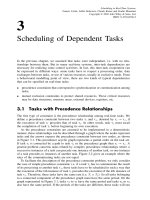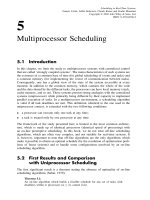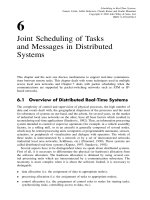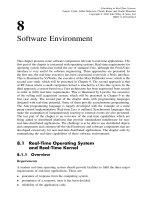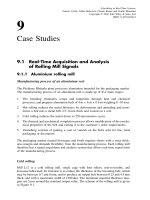Tài liệu Lịch khai giảng trong các hệ thống thời gian thực P3 pdf
Bạn đang xem bản rút gọn của tài liệu. Xem và tải ngay bản đầy đủ của tài liệu tại đây (560.03 KB, 28 trang )
3
Scheduling of Dependent Tasks
In the previous chapter, we assumed that tasks were independent, i.e. with no rela-
tionships between them. But in many real-time systems, inter-task dependencies are
necessary for realizing some control activities. In fact, this inter-task cooperation can
be expressed in different ways: some tasks have to respect a processing order, data
exchanges between tasks, or use of various resources, usually in exclusive mode. From
a behavioural modelling point of view, there are two kinds of typical dependencies
that can be specified on real-time tasks:
• precedence constraints that correspond to synchronization or communication among
tasks;
• mutual exclusion constraints to protect shared resources. These critical resources
may be data structures, memory areas, external devices, registers, etc.
3.1 Tasks with Precedence Relationships
The first type of constraint is the precedence relationship among real-time tasks. We
define a precedence constraint between two tasks τ
i
and τ
j
, denoted by τ
i
→ τ
j
,if
the execution of task τ
i
precedes that of task τ
j
. In other words, task τ
j
must await
the completion of task τ
i
before beginning its own execution.
As the precedence constraints are assumed to be implemented in a deterministic
manner, these relationships can be described through a graph where the nodes represent
tasks and the arrows express the precedence constraint between two nodes, as shown
in Figure 3.1. This precedence acyclic graph represents a partial order on the task set.
If task τ
i
is connected by a path to task τ
j
in the precedence graph then τ
i
→ τ
j
.A
general problem concerns tasks related by complex precedence relationships where n
successive instances of a task can precede one instance of another task, or one instance
of a task precedes m instances of another task. Figure 3.2 gives an example where the
rates of the communicating tasks are not equal.
To facilitate the description of the precedence constraint problem, we only consider
the case of simple precedence constraint, i.e. if a task τ
i
has to communicate the result
of its processing to another task τ
j
, these tasks have to be scheduled in such a way that
the execution of the kth instance of task τ
i
precedes the execution of the kth instance of
task τ
j
. Therefore, these tasks have the same rate (i.e. T
i
= T
j
). So all tasks belonging
to a connected component of the precedence graph must have the same period. On the
graph represented in Figure 3.1, tasks τ
1
to τ
5
have the same period and tasks τ
6
to τ
9
also have the same period. If the periods of the tasks are different, these tasks will run
Scheduling in Real-Time Systems.
Francis Cottet, Jo¨elle Delacroix, Claude Kaiser and Zoubir Mammeri
Copyright
2002 John Wiley & Sons, Ltd.
ISBN: 0-470-84766-2
52 3 SCHEDULING OF DEPENDENT TASKS
τ
1
τ
4
τ
5
τ
2
τ
3
τ
6
τ
7
τ
8
τ
9
Figure 3.1 Example of two precedence graphs related to a set of nine tasks
τ
1
Temperature
measurement
task
τ
2
Average
temperature
over four samples
calculation
task
T
2
= 4T
1
Figure 3.2 Example of a generalized precedence relationship between two tasks with differ-
ent periods
at the lowest rate sooner or later. As a consequence the task with the shortest period
will miss its deadline. We do not consider cyclical asynchronous message buffers.
An answer to the first question was given by Blazewicz (1977): if we have to get
τ
i
→ τ
j
, then the task parameters must be in accordance with the following rules:
• r
j
≥ r
i
• Prio
i
≥ Prio
j
in accordance with the scheduling algorithm
In the rest of this chapter, we are interested in the validation context. This problem
can be studied from two points of view: execution and validation. First, in the case of
preemptive scheduling algorithms based on priority, the question is: which modification
of the task parameters will lead to an execution that respects the precedence constraints?
Second, is it possible to validate apriori the schedulability of a dependent task set?
3.1.1 Precedence constraints and fixed-priority
algorithms (RM and DM)
The rate monotonic scheduling algorithm assigns priorities to tasks according to their
periods. In other words, tasks with shorter period get higher priorities. Respecting this
rule, the goal is to modify the task parameters in order to take account of precedence
constraints, i.e. to obtain an independent task set with modified parameters. The basic
idea of these modifications is that a task cannot start before its predecessors and cannot
preempt its successors. So if we have to get τ
i
→ τ
j
, then the release time and the
priority of task parameters must be modified as follows:
• r
∗
j
≥ Max(r
j
,r
∗
i
)r
∗
i
is the modified release time of task τ
i
• Prio
i
≥ Prio
j
in accordance with the RM algorithm
3.1 TASKS WITH PRECEDENCE RELATIONSHIPS 53
τ
1
τ
2
τ
3
τ
5
τ
6
τ
4
Figure 3.3 Precedence graphs of a set of six tasks
Table 3.1 Example of priority mapping taking care of
precedence constraints and using the RM scheduling
algorithm
Task τ
1
τ
2
τ
3
τ
4
τ
5
τ
6
Priority654321
It is important to notice that, as all tasks of a precedence graph share the same period,
according to RM policy there is a free choice concerning the priorities that we use
to impose the precedence order. Let us consider a set of six tasks with simultaneous
release times and two graphs describing their precedence relationships (Figure 3.3).
The priority mapping, represented in Table 3.1, handles the precedence constraint and
meets the RM algorithm rule.
The deadline monotonic scheduling algorithm assigns priorities to tasks according to
their relative deadline D (tasks with shorter relative deadline get higher priorities). The
modifications of task parameters are close to those applied for RM scheduling except
that the relative deadline is also changed in order to respect the priority assignment.
So if τ
i
→ τ
j
, then the release time, the relative deadline and the priority of the task
parameters must be modified as follows:
• r
∗
j
≥ Max(r
j
,r
∗
i
) r
∗
i
is the modified release time of task τ
i
• D
∗
j
≥ Max(D
j
,D
∗
i
) D
∗
i
is the modified relative deadline of task τ
i
• Prio
i
≥ Prio
j
in accordance with the DM scheduling algorithm
This modification transparently enforces the precedence relationship between two tasks.
3.1.2 Precedence constraints and the earliest deadline
first algorithm
In the case of the earliest deadline first algorithm, the modification of task parameters
relies on the deadline d. So the rules for modifying release times and deadlines of
tasks are based on the following observations (Figure 3.4) (Blazewicz, 1977; Chetto
et al., 1990).
54 3 SCHEDULING OF DEPENDENT TASKS
Modification of r
*
i
Modification of d
*
i
C
1
C
3
t
r
1
r
2
r
*
2
d
*
2
d
2
d
3
τ
1
τ
2
τ
3
Figure 3.4 Modifications of task parameters in the case of EDF scheduling
First, if we have to get τ
i
→ τ
j
, the release time r
∗
j
of task τ
j
must be greater than
or equal to its initial value or to the new release times r
∗
i
of its immediate predecessors
τ
i
increased by their execution times C
i
:
r
∗
j
≥ Max((r
∗
i
+ C
i
), r
j
)
Then, if we have to get τ
i
→ τ
j
, the deadline d
∗
i
of task τ
i
has to be replaced by the
minimum between its initial value d
i
or by the new deadlines d
∗
j
of the immediate
successors τ
j
decreased by their execution times C
j
:
d
∗
i
≥ Min((d
∗
j
− C
j
), d
i
)
Procedures that modify the release times and the deadlines can be implemented in an
easy way as shown by Figure 3.4. They begin with the tasks that have no predecessors
for modifying their release times and with those with no successors for changing
their deadlines.
3.1.3 Example
Let us consider a set of five tasks whose parameters (r
i
,C
i
,d
i
) are indicated in
Table 3.2. Note that all the tasks are activated simultaneously except task τ
2
.Their
precedence graph is depicted in Figure 3.5. As there is one precedence graph linking
Table 3.2 Set of five tasks and the modifications of parameters according to the precedence
constraints (4 is the highest priority)
Initial task parameters Modifications to use
RM
Modifications to use
EDF
Task r
i
C
i
d
i
r
∗
i
Prio
i
r
∗
i
d
∗
i
τ
1
015030 3
τ
2
527545 7
τ
3
025021 5
τ
4
0110517 9
τ
5
0 3 12 5 0 8 12
3.2 TASKS SHARING CRITICAL RESOURCES 55
τ
3
τ
1
τ
4
τ
5
τ
2
Figure 3.5 Precedence graph linking five tasks
all the tasks of the application, we assume that all these tasks have the same rate.
Table 3.2 also shows the modifications of task parameters in order to take account of
the precedence constraints in both RM and EDF scheduling.
Let us note that, in the case of RM scheduling, only the release time parameters are
changed and the precedence constraint is enforced by the priority assignment. Under
EDF scheduling, both parameters (r
i
,d
i
) must be modified.
3.2 Tasks Sharing Critical Resources
This section describes simple techniques that can handle shared resources for dynamic
preemptive systems. When tasks are allowed to access shared resources, their access
needs to be controlled in order to maintain data consistency. Let us consider a critical
resource, called R,sharedbytwotasksτ
1
and τ
2
. We want to ensure that the sequences
of statements of τ
1
and τ
2
, which perform on R, are executed under mutual exclusion.
These pieces of code are called critical sections or critical regions. Specific mechanisms
(such as semaphore, protected object or monitor), provided by the real-time kernel,
can be used to create critical sections in a task code. It is important to note that,
in a non-preemptive context, this problem does not arise because by definition a task
cannot be preempted during a critical section. In this chapter, we consider a preemptive
context in order to allow fast response time for high-priority tasks which correspond
to high-safety software.
Let us consider again the small example with two tasks τ
1
and τ
2
sharing one
resource R. Let us assume that task τ
1
is activated first and uses resource R,i.e.
enters its critical section. Then the second task τ
2
, having a higher priority than τ
1
,
asks for the processor. Since the priority of task τ
2
is greater, preemption occurs, task
τ
1
is blocked and task τ
2
starts its execution. However, when task τ
2
wants access
to the shared resource R, it is blocked due to the mutual exclusion process. So task
τ
1
can resume its execution. When task τ
1
finishes its critical section, the higher
priority task τ
2
can resume its execution and use resource R. This process can lead
to an uncontrolled blocking time of task τ
2
.Onthecontrary,tomeethardreal-time
requirements, an application must be controlled by a scheduling algorithm that can
always guarantee a predictable system response time. The question is how to ensure
a predictable response time of real-time tasks in a preemptive scheduling mechanism
with resource constraints.
56 3 SCHEDULING OF DEPENDENT TASKS
3.2.1 Assessment of a task response time
In this section, we consider on-line preemptive scheduling where the priorities are fixed
and assigned to tasks. We discuss the upper bound of the response time of a task τ
0
which has a worst-case execution time C
0
. Let us assume now that the utilization factor
of the processor is low enough to permit the task set, including τ
0
, to be schedulable
whatever the blocking time due to the shared resources.
In the first step, we suppose that the tasks are independent, i.e. without any shared
resource. If task τ
0
has the higher priority, it is obvious that the response time TR
0
of
this task τ
0
is equal to its execution time C
0
. On the other hand, when task τ
0
has an
intermediate priority, the upper bound of the response can also be evaluated easily as
a function of the tasks with a priority higher than that of task τ
0
, denoted τ
HPT
:
• Where all tasks are periodic with the same period or aperiodic, we obtain:
TR
0
≤ C
0
+
i∈HPT
C
i
(3.1)
• Where all tasks are periodic with different periods, we obtain:
TR
0
≤ C
0
+
i∈HPT
T
0
T
i
C
i
(3.2)
In the second step, we consider a task set sharing resources. The assumptions are
the following. Concerning task dispatching or resource access, the management of all
the queues is done according to the task priorities. Moreover, we assume that the
overhead due to kernel mechanisms (resource access, task queuing, context switches)
is negligible. Of course, these overheads can be taken into account as an additional
term of task execution times.
Now, in the context of a set with n + 1 tasks and m resources, let us calculate
the upper bound of the response time of task τ
0
(i) when it does and (ii) when it
does not hold the highest priority. First, when task τ
0
has the highest priority of the
task set, its execution can be delayed only by the activated tasks which have a lower
priority and use the same m
0
shared resources. This situation has to be analysed for
two cases:
• Case I: The m
0
shared resources are held by at least m
0
tasks as shown in Figure 3.6,
where task τ
j
holds resource R
1
requested by task τ
0
. It is important to notice that
task τ
i
waiting for resource R
1
is preempted by task τ
0
due to the priority order-
ing management of queues. Let CR
i,q
denote the maximum time the task τ
i
uses
resource R
q
, CR
max,q
the maximum of CR
i,q
over all tasks τ
i
, CR
i,max
the max-
imum of CR
i,q
over all resources R
q
, and finally CR
max
the maximum of CR
i,q
over all tasks and resources. As a consequence, the upper bound of the response
time of task τ
0
is given by:
TR
0
≤ C
0
+
m
0
i=1
CR
i,max
(3.3)
3.2 TASKS SHARING CRITICAL RESOURCES 57
t
II
t
t
t
t
R
1
R
1
R
1
R
1
R
i
R
j
Critical resource
use
Critical resource
request
Critical resource
release
R
2
R
3
R
4
R
1
R
1
R
1
r
r
t
R
2
,
R
3
,
R
4
R
3
,
R
4
R
4
R
3
R
2
R
2
,
R
3
,
R
4
TR
0
TR
0
I
τ
0
τ
i
τ
j
τ
0
τ
k
τ
j
R
1
Figure 3.6 Response time of the highest priority task sharing critical resources: Case I: two
lower priority tasks sharing a critical resource with task
τ
0
. Case II: two lower priority tasks
sharing three critical resources with task
τ
0
In the worst case, for this set (n other tasks using the m resources, with n<m),
the response time is at most:
TR
0
≤ C
0
+ m · CR
max
(3.4)
Or more precisely, we get:
TR
0
≤ C
0
+
m
i=1
CR
i,max
(3.5)
• Case II: The m
0
shared resources are held by n
1
tasks with n
1
<m
0
, as shown
in Figure 3.6, where tasks τ
k
and τ
j
hold resources R
2
,R
3
and R
4
requested by
τ
0
. We can notice that, at least, one task holds two resources. If we assume that
the critical sections of a task are properly nested, the maximum critical section
duration of a task using several resources is given by the longest critical section.
So the response time of task τ
0
is upper-bounded by:
TR
0
≤ C
0
+ n
1
· CR
max
(3.6)
58 3 SCHEDULING OF DEPENDENT TASKS
Or more precisely, we get:
TR
0
≤ C
0
+
n
1
q=1
CR
max,q
(3.7)
In the worst case, for this set (n other tasks and m resources, with n<m), the
response time of task τ
0
is at most:
TR
0
≤ C
0
+ n · CR
max
(3.8)
Or more precisely, we get:
TR
0
≤ C
0
+
n
q=1
CR
max,q
(3.9)
To sum up, an overall expression of the response time for the highest priority task
in a real-time application composed of n + 1 tasks and m resources is given by the
following inequality:
TR
0
≤ C
0
+ inf(n, m) · CR
max
(3.10)
Let us consider now that task τ
0
has an intermediate priority. The task set includes n
1
tasks having a higher priority level (HPT set) and n
2
tasks which have a lower priority
level and share m critical resources with task τ
0
. This case is depicted in Figure 3.7
with the following specific values: n
1
= 1,n
2
= 2andm = 3. With the assumption
that the n
2
lower priority tasks haves dependencies only with τ
0
, and not with the n
1
higher priority tasks, it should be possible to calculate the upper bound of the response
time of task τ
0
by combining inequalities (3.2) and (3.10). The response time is:
TR
0
≤ C
0
+ inf(n
1
,m)· CR
max
+
i∈HPT
T
0
T
i
C
i
(3.11)
τ
0
τ
k
τ
i
R
1
R
i
R
i
R
2
R
3
t
t
t
t
τ
j
r
Critical resource
use
Critical resource
request
Critical resource
release
TR
0
R
1
R
2
R
3
R
3
R
1
R
1
,R
3
R
3
R
2
R
2
R
1
R
2
Figure 3.7 Response time of task sharing critical resources: Prio
i
> Prio
0
> Prio
j
> Prio
k
3.2 TASKS SHARING CRITICAL RESOURCES 59
However, this computation of the upper bound of each task relies on respect for the
assumptions concerning the scheduling rules. In particular, for a preemptive schedul-
ing algorithm with fixed priority, there is an implicit condition of the specification
that must be inviolable: at its activation time, a task τ
0
must run as soon as all the
higher priority tasks have finished their execution and all the lower priority tasks using
critical resources, requested by τ
0
, have released the corresponding critical sections. In
fact two scheduling problems can render this assumption false: the priority inversion
phenomenon and deadlock.
3.2.2 Priority inversion phenomenon
In preemptive scheduling that is driven by fixed priority and where critical resources
are protected by a mutual exclusion mechanism, the priority inversion phenomenon
can occur (Kaiser, 1981; Rajkumar, 1991; Sha et al., 1990). In order to illustrate
this problem, let us consider a task set composed of four tasks {τ
1
, τ
2
, τ
3
, τ
4
} hav-
ing decreasing priorities. Tasks τ
2
and τ
4
share a critical resource R
1
, the access
of which is mutually exclusive. Let us focus our attention on the response time of
task τ
2
. The scheduling sequence is shown in Figure 3.8. The lowest priority task
τ
4
starts its execution first and after some time it enters a critical section using
resource R
1
.Whentaskτ
4
is in its critical section, the higher priority task τ
2
is
released and preempts task τ
4
. During the execution of task τ
2
,taskτ
3
is released.
Nevertheless, task τ
3
, having a lower priority than task τ
2
, must wait. When task
τ
2
needs to enter its critical section, associated with the critical resource R
1
shared
with task τ
4
, it finds that the corresponding resource R
1
is held by task τ
4
. Thus it
is blocked. The highest priority task able to execute is task τ
3
.Sotaskτ
3
gets the
processor and runs.
During this execution, the highest priority task τ
1
awakes. As a consequence task τ
3
is suspended and the processor is allocated to task τ
1
. At the end of execution of task
τ
1
,taskτ
3
can resume its execution until it reaches the end of its code. Now, only the
lowest priority task τ
4
, preempted in its critical section, can execute again. It resumes
τ
1
τ
2
τ
3
τ
4
t
Critical section
Critical resource
request
R
1
R
1
R
1
R
1
R
1
t
t
t
Critical resource
release
Figure 3.8 Example of priority inversion phenomenon
60 3 SCHEDULING OF DEPENDENT TASKS
its execution until it releases critical resource R
1
required by the higher priority task
τ
2
. Then, this task can resume its execution by holding critical resource R
1
necessary
for its activity.
It is of great importance to analyse this simple example precisely. The maximum
blocking time that task τ
2
may experience depends on the duration of the critical
sections of the lower priority tasks sharing a resource with it, such as task τ
4
, and on
the other hand on the execution times of higher priority tasks, such as task τ
1
.These
two kinds of increase of the response time of task τ
2
are completely consistent with
the scheduling rules. But, another task, τ
3
, which has a lower priority and does not
share any critical resource with task τ
2
, participates in the increase of its blocking time.
This situation, called priority inversion, contravenes the scheduling specification and
can induce deadline missing as can be seen in the example given in Section 9.2. In
this case the blocking time of each task cannot be bounded unless a specific protocol
is used and it can lead to uncontrolled response time of each task.
3.2.3 Deadlock phenomenon
When tasks share the same set of two or more critical resources, then a deadlock
situation can occur and, as a consequence, the real-time application fails. The notion
of deadlock is better illustrated by the following simple example (Figure 3.9a).
Let us consider two tasks τ
1
and τ
2
that use two critical resources R
1
and R
2
. τ
1
and τ
2
access R
1
and R
2
in reverse order. Moreover, the priority of task τ
1
is greater
than that of task τ
2
. Now, suppose that task τ
2
executes first and locks resource R
1
.
t
t
Task executing
Task using resource R
1
R
1
R
2
R
1
R
2
R
1
, R
2
R
1
R
2
Task using resources R
1
and R
2
Deadlock
t
t
(a) Deadlock
(b) Total ordering method
End of τ
1
τ
1
τ
2
τ
1
τ
2
R
1
R
2
R
2
R
1
Figure 3.9 (a) Example of the deadlock phenomenon. (b) Solution for deadlock prevention by
imposing a total ordering on resource access
3.2 TASKS SHARING CRITICAL RESOURCES 61
During the critical section of task τ
2
using resource R
1
,taskτ
1
awakes and preempts
task τ
2
before it can lock the second resource R
2
.Taskτ
1
needs resource R
2
first,
which is free, and it locks it. Then task τ
1
needs resource R
1
, which is held by task
τ
2
.Sotaskτ
2
resumes and asks for resource R
2
, which is not free. The final result is
that task τ
2
is in possession of resource R
1
but is waiting for resource R
2
and task τ
1
is in possession of resource R
2
but is waiting for resource R
1
. Neither task τ
1
nor task
τ
2
will release the resource until its pending request is satisfied. This situation leads to
a deadlock of both tasks. This situation can be extended to more than two tasks with
a circular resource access order and leads to a chained blocking.
Deadlock is a serious problem for critical real-time applications. Solutions must
be found in order to prevent deadlock situations, as classically done for operating
systems (Bacon, 1997; Silberschatz and Galvin, 1998; Tanenbaum, 1994; Tanenbaum
and woodhull, 1997). One method is to impose a total ordering of the critical resource
accesses (Havender, 1968). It is not always possible to apply this technique, because it
is necessary to know all the resources that a task will need during its activity. This is
why this method is called static prevention (Figure 3.9b). Another technique that can
be used on-line is known as the banker’s algorithm (Haberman, 1969), and requires
that each task declares beforehand the maximum number of resources that it may hold
simultaneously.
Other methods to cope with deadlocks are based on detection and recovering pro-
cesses (for example by using a watchdog timer). The use of a watchdog timer allows
detection of inactive tasks: this may be a deadlock, or the tasks may be waiting for
external signals. Then, the technique for handling the deadlock is to reset the tasks
involved in the detected deadlock or, in an easier way, the whole task set. This method,
used very often when the deadlock situation is known to occur infrequently, is not
acceptable for highly critical systems.
3.2.4 Shared resource access protocols
Scheduling of tasks that share critical resources leads to some problems in all computer
science applications:
• synchronization problems between tasks and particularly the priority inversion sit-
uation when they share mutually exclusive resources;
• deadlock and chained blocking problems.
In real-time systems, a simple method to cope with these problems is the reservation and
pre-holding of resources at the beginning of task execution. However, such a technique
leads to a low utilization factor of resources, so some resource access protocols have
been designed to avoid such drawbacks and also to bound the maximum response time
of tasks.
Different protocols have been developed for preventing the priority inversion in the
RM or EDF scheduling context. These protocols permit the upper bound of the blocking
time due to the critical resource access for each task τ
i
to be determined. This is called
B
i
. This maximum blocking duration is then integrated into the schedulability tests
of classical scheduling algorithms like RM and EDF (see Chapter 2). This integration


